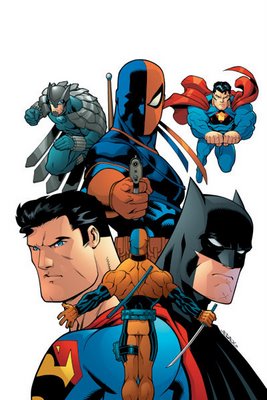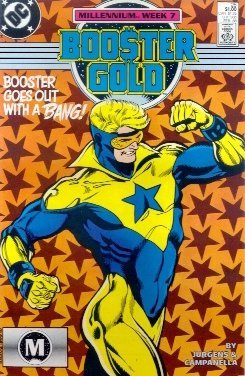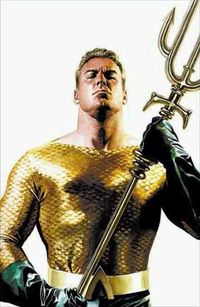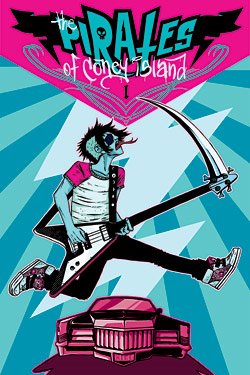 52 #25 (DC Comics)
52 #25 (DC Comics) This issue of DC’s weekly series, like last week’s, is exactly what you would expect a book about the DC Universe as a whole to be like, and, as a fan of that fictional shared setting, it’s everything I could ask for from such a series. This week’s issue checks in on all sorts of corners of the DCU. Old Superman bad guys Intergang have been completely reinvented, evolving from a mob who received alien technology from the evil “New Gods” to a sort of evil religious movement that seemingly worships the evil New Gods (The language is coy, but in describing his Road of Damascus moment, Intergang’s crime pope Boss Bruno Mannheim speaks of “a dark angel made of living granite” that whispered to him, “the sickening secrets of the Dark Side,” the name co-writer Grant Morrison assigned to Kirby’s Darkseid in his
Mister Miracle mini). It’s an elegantly handled three pages, even if the writers spontaneously change P.O.V. and add narration again. Next stop, a Halloween celebration with the Marvel Family and the Black Marvel Family, as they save the day from an ass-kicking new version of “SABBAC! King of devils!” (Osiris to the rescued trick-or-treaters: “Happy Halloween, Judeo-Christians!”) But wait, there’s more! The Helmet of Fate takes Ralph Dibny to “Elsewhere” (read: Hell) to visit the soul of Felix Faust, the new Infinity Inc. takes on the Icicle and Tigress, Alan Scott and Michael Holt discuss whether or not he should start a spy organization to go along with his new Nick Fury look and, finally, we check back in with Morrow, Magnus and the gang on Oolong Island, where the man, er,
thing behind the operation is finally revealed (It’s exactly who you suspect). Back-up origin is Nightwing by George Perez; nicely drawn, but missing a
lot of info, and way too focused on ‘wing’s crazy present rather than his past or future. Confidential to DC: I think I’ve found the creative team to follow Brad Meltzer and Ed Benes on
Justice League of America. Let’s let Morrison, Mark Waid and Geoff Johns tackle the League as a team, and let Phil Jimenez draw it, huh?
Action Comics # 844 (DC) At long last, the other Kubert drops. The new creative team on
Action finally makes it’s debut, with Adam Kubert on art chores and the writing team of Geoff Johns and Richard Donner handling the story. It’s unfortunate that such a high-profile team is coming on at the end of October instead of, say, in the spring or early summer, when mainstream interest in Superman (and the film work of Donner) was at it’s crest instead of it’s nadir. But, for our purposes, as readers who were going to be all over a Kubert-drawn Superman title no matter
who was writing it, I suppose it doesn’t matter much when they started, just that they did. The story is cinematic, which is perhaps to be expected, and, surprisingly enough, explores similar territory to Bryan Singer’s
Superman Returns. It’s a nice start to what could be a strong story; between the promise of this run, and Kurt Busiek’s work on
Superman and Morrison and Frank Quitely’s
All-Star Superman, DC’s flagship franchise is in the best shape of it’s long, long life. Nitpick #1: So Perry smokes cigars now, too, huh? Does
everybody in the DCU smoke post-
Infinite Crisis? (Looks like; there’s Sarge Steel lighting up). Okay, but why’s Perry smoking at
work? He runs a newspaper, not a bar, and even bars in some big, metropolitan cities are smoke-free. Nitpick #2: “Kryptonese?” I thought Kryptonians spoke Kryptonian? Ah, Superboy-Prime, is there any mistake your fists can’t be used to explain away?
Black Panther #21 (Marvel) Let me get this out of the way first, because it was honestly the only thing I didn’t like about this issue: Manuel Garcia’s pencil art wasn’t that great. Oh, it wasn’t terrible or anything, but his Namor really lacked personality, and some of the peculiararities that make Namor Namor, from the shape of his head to his widow’s peak to his ears to his eyebrows. Garcia also has trouble with Storm’s head, which changes shape from panel to panel. The storytelling was decent, but the art lacked style and snap, and this was a great little story that deserved visuals to match it. T’Challa and Storm visit Atlantis (via Panther Sub, naturally) to discuss politics with Namor. For the first time in this arc, diplomacy doesn’t involve a brawl, perhaps because the Panther vs. Namor moment comes in a story Namor tells, about the Invaders’ coming across T’Challa’s granddad (whose WWII-era Panther Plane design was the highlight of Garcia’s work here. God that looked cool!). Hudlin writes Namor even better than he does T’Challa (I’d want to see more before I officially start wishing for a Hudlin-written Namor ongoing though), and he throws a nice jab at the president into one four-panel scene on page one. Tony Stark better rush his Clors into mass-production stat; it looks like he’s gonna need someone on his side, since his numbers continue to dwindle and Cap keeps picking up uber-powerful allies.
The Boys #4 (WildStorm/DC) Okay, the Starlight recruitment scene in the last issue made me feel pretty awkward, hell, even a little sick, but it was momentary. But this issue? Well, congratulations are in order, Garth Ennis, because this time I felt a lot sick, and on more than one occasion (thanks, in large part, to how realistically Darick Robertson renders things like blood-flecked semen and the look of pain, sadness and existential horror on the faces of prostitutes and, on occasion, Starlight).
Civil War: Choosing Sides (Marvel Comics) I know it’s not a popular opinion to be
glad that Marvel’s red hot
Civil War event, which pretty much their entire line is tied into, has been delayed, but if it got us this one-shot, created as a sort of stop-gap to pick up some of the sales slack that a late-shipping
Civil War #5 would create, well, let’s just say that there’s a silver lining to the delay, shall we? Okay, so everyone knows what side Iron Man and Cap are on, but what about Venom, Iron Fist, U.S. Agent, the new Ant-Man and, most importantly, Howard the Duck? This is the one-shot that lets us know what side these minor characters choose. So, let’s see: Pro-Reg, Anti-Reg, Pro-Reg, Neutral (but enjoying the show) and Neutral/Exempt (on account of being beneath the government’s notice). This book is actually a smart move on Marvel’s part, acting as a preview of two books that spin directly out of
Civil War (The new version of
Thunderbolts and
Omega Flight) and previewing two new books starring minor characters (the excellent
Irredeemable Ant-Man and the upcoming
Immortal Iron Fist), plus giving us a Howard the Duck story to make fun of the whole shebang. This book was full of fun moments, particularly Marc Guggenheim’s Venom script (Sorry Marc, your bother’s
Miracle did kinda suck) and the Ant-Man and Howard stories. Still, with a book like this, there are always a few nits to pick. Like the whole mass-murderers-as-policemen concept behind
Thunderbolts, which Guggenheim actually accentuates by having Venom kill six SHIELD agents while in the process of agreeing to work for SHIELD. Nitpick #2 is directed at Ty Templeton, who wrote the Howard story, which is set partially in a Cleveland, Ohio Department of Motor Vehicles. Just one small problem. Ohio doesn’t have a Department of Motor Vehicles! It’s the
Bureau of Motor Vehicles!!! No-Prize Wanna-winners, start your theorizing on why an Ohio BMV employee refers to her place of employment as the DMV instead, and send your letters to Tom Brevoort.
Conan and the Songs of the Dead #4 (Dark Horse Comics) Writer Joe R. Lansdale and artist Timothy Truman’s take on everybody’s favorite barbarian just gets better and better with each issue, and it started out pretty damn strong to begin with. This issue is the funniest and most fun to date, but my favorite part came not in the story itself, but the letter page. The part where editor Scott Allie mentions that they’re already talking about when Lansdale and Truman can team back up for another spin through the world of Robert E. Howard.
Jack The Lantern: Ghosts #1 (Castle Rain Entertainment) I’m not exactly sure why, but I just really like the idea of characters with pumpkins for heads, and I really like names that are riffs on jack o’ lanterns. It’s just an instinctual, aesthetic thing with no explanation that I can think of (Not that I’ve thought too long and hard on the subject, mind you). Given all that, the pumpkin-headed supernatural hero Jack The Lantern seems like one I’d be predisposed to be into, but this is the first time I’ve actually brought a comic book starring him home. There’s something about the character design—that ‘80s horror movie rubber Halloween mask look, the asymmetrical eyes—that always had me putting the book back on the shelf after an in-store flip-through. Well, this is the first issue featuring the character that I actually brought all the way home to read, helped along in my decision-making process by the exceptionally low cover price—Only $1.25! I’d like to say it was worth every penny, but, well, I still feel like I overpaid. Granted, this wasn’t the best jumping on point, as I missed the entire backstory summarized on the title page—demons from beyond, evil book, blah blah blah—but I felt pretty lost throughout, and never found my footing. The black and white pencil art, by Jerry Beck and Tim Vigil, was fine, but I feel this is probably a character that needs to be in color, so you can really appreciate the orange-ness of his head and the greenish color of the will o' the wisp-like flames that pour out the top. There was a nice Green Goblin-esque design of a villain near the end, and the last page had one or two solid bad guy designs, but I never shook the feeling that I’d walked into a bd movie way too late.
JSA: Classified #18 (DC) In the concluding issue of their two-part Hourmen vs. Bane story, Tony Bedard and Scott McDaniel redeem the man who broke the Bat (Aha! So he wasn’t actually the putz the first issue made him out to be!), and Bedard tones down the overly affected Spanish lingo in the big guy’s dialogue. After this arc and his work on the covers of the brilliant but cancelled Tom Peyer/Rags Morales
Hourman monthly, I think it’s safe to declare McDaniel the definitive Miralco pill artist (for whatever that’s worth).
Justice #8 (DC) Alex Ross and company’s occasional JLA book keeps getting better and better, and this issue is devoted almost entirely to nice little character-building moments between the various Leaguers. Page one gives us the World’s Finest team talking about their relationship for the one millionth time (Ross and Jim Krueger find a new angle though, making it sound fresh), page 16 a nice bit between Captain Marvel and Wonder Woman, and page 13 a tense conversation between the Elongated Man and Plastic Man (“Oh, man, this isn’t going to be another one of
those talks, is it?” Plas starts off, “I’m sorry you’re not the only stretchy guy in the League.”) By finding and exploring the little differences between such similar characters Krueger and Ross show that so much of the conventional wisdom about the Justice League and it’s make up (Captain Marvel and Superman are too similar, you can have Elongated Man or Plas but not both, Martian Manhunter and Aquaman are boring, etc.) is actually conventional foolishness. Confidential to whoever it was at DC that greenlighted
Trials of Shazam and
Martian Manhunter: See, there was nothing wrong with these characters; they just needed creators who get them to give them a whirl. Confidential to whomever at DC will be editing
JLofA after Meltzer splits: If the
52 team isn’t available to take the reigns, why not give them to Krueger, Ross and Braithwaite?
New Avengers #24 (Marvel) I’d say something flippant, perhaps like, “I had to double check the cover to make sure this was an issue of
Avengers and not a Sentry solo title after I started reading,” but who am I kidding? At this point, there’s nothing at all surprising about the fact that writer Brian Michael Bendis’ Avengers-less Avengers title hardly has anything to do with anyone on the team at all. This is a Sentry story—just as the last one was a Spider-Woman story, and the one before that a Luke Cage story, and the one before that a Captain America and Falcon story—rather than an Avengers story, and it feels even more divorced from the team than any of the previous issues of this arc, given the fact that the Sentry has never really been part of the team at all (He showed up to help them fight the Collective in the previous story arc and, um, that’s it so far). I think Bendis and Marvel are really missing an opportunity with this arc—if any title should tie directly into the
Civil War story, which is essentially about the breakdown in Iron Man and Captain America’s relationship, shouldn’t it be the one title that’s always featured Iron Man and Captain America’s relationship? But, like I said, at this point, it’s pointless to complain. As a Sentry story, it’s not a bad one, as Bendis lets us in on the most powerful superhero in the Marvel Universe’s thoughts, and we watch him retreat from Earth to find peace and quiet on the moon. What he finds instead are the Inhumans and, finally, Iron Man, who recruits him (Looks like he’s going to need him, as virtually the entire Marvel Universe is opposed to Iron Man). The art by Pasqual Ferry is simply astonishing, and he brings the unreality—the inhumanity, I guess—of the Inhumans to tangible life. He and Bendis work quite well together on a storytelling level, and the scene where we watch the Sentry’s face reflect in Iron Man’s mask and zoom in on the reflection in the reflection is a wonderful little moment. But, as always, it’s the little things that make this book so exasperating, like Bendis’ (or is it Sentry’s?) loose grip on what
Civil War is about exactly (from this issue, you’d think it spun directly out of
Secret War and
House of M rather than the Stamford disaster), and the simple yet frustrating fact that Sentry’s hair is so different on the cover than it is in the story itself.
Secret Six #5 (DC) Gail Simone give us the most fun issue yet of her six-part miniseries pitting bad guys versus much, much worse bad guys. The first third of the book features most of the cast fighting and arguing while completely naked (except for Hatter’s hat, of course), and we finally get the Mad Hatter vs. Dr. Psycho fight I’ve been waiting for since the first issue. Best line? Courtesy of the Hatter: “Dr. Psycho, is it? Why not pick on someone your own size?” I love a lot of these characters, and I love the way Simone writes them even more. I hope at least the boys on this team—Catman, Deadshot, Hatter and the Ragdoll—survive, and that sales are strong enough to give us a Simone-written ongoing. Brad Walker’s art gets stronger each issue, and I wouldn’t mind him sticking with Simone and the characters in the future, though inker Jimmy Palmiotti doesn’t mesh with Walker’s pencils as well as Troy Nixey did in the otherwise mostly forgettable “War Games” crossover in the Bat-titles.
Stan Lee Meets The Thing #1 (Marvel) The Lee-written lead-in featuring art by Lee Weeks is only so-so (though I admit I’ve always like Lee’s Ben Grimm dialogue) as is the Roy Thomas/Scott Kollins back-up, in which WWII-era Sgt. Stan Lee calls in the Invaders and gets some also-rans (The Destroyer, Father Time and Jack Frost). The biggest surprise was seeing a short story by
Angry Youth Comix Johnny Ryan. It’s fun to see Ryan’s familiar style drawing The Watcher, the Blob and Stan Lee himself, by the story’s not really as funny as the fact that Johnny Ryan drew a story for Marvel at all. Obviously, it’s nowhere near as aggressively tasteless as his Fantagraphics work, but then, Marvel probably wouldn’t even publish a Johnny Ryan unchained story in a Max book, let alone an all-ages Marvel book.
Superman/Batman Annual #1 (DC) I wasn’t too terribly excited about this book going in, despite the exciting creative team involved. Titans villain-turned-ubiquitous threat Deathstroke the Terminator has gotten so overexposed since
Identity Crisis that I cringe at the very sight of him on a cover these days, and there he was, pointing a gun at a slightly different version of himself. Well, my excitement would build with each and every page, as this whole oversized book was on heaping helping of zany, courtesy of Joe Kelly and a top-flight art team led off by Ed McGuinness. The continuity conscious might have some difficulties, but I stopped worrying and learned to love it fairly quickly, and I’m as anal as they come when it comes to DC continuity (It helped that the book is labeled “A Re-Imaginary Story” and that there’s a pixie present in a key scene). Set during year one or so, when the title characters are still trying to determine each others identities and seem to have quite a rivalry going on, Deathstroke has been hired to kill Bruce Wayne on a cruise to the Bermuda Triangle, a cruise also attended by Clark Kent and Lois Lane. In the triangle, they cross over into Grant Morrison and Frank Quitely’s
Earth-2, where their evil doppelgangers Ultraman, Owlman and Superwoman join the fray, as does Deathstroke’s heroic antimatter counterpart, who bears more than a striking to resemblance to a certain Marvel
character (Every time he tries to say his name, however, he suffers a painful deathblow that would kill someone without his healing factor). This book was so much fun, that I really wish Kelly would have taken over the
Superman/Batman monthly (along with an artist who can meet deadlines). He really manages to play the relationship between Superman and Batman as a true friendship, complete with unfriendly competition and a need to constantly bust on one another, rather than some sort of tense alliance of necessity or staid partnership forged in respect. Now, I do hope DC realizes they have to do one again next year, or else it’s not really an “Annual” per se…
Ultimate Spider-Man #101 (Marvel) See, this is exactly why Bendis’
New Avengers frustrates the hell out of me. It’s not that it’s ever terrible or even pretty bad, although it rarely feels like Marvel’s flagship title or what a book about the universe’s premiere superteam should feel like, but because Bendis demonstrates month in and month out just how capable he is of creating a kick ass superhero book. If
Ultimate Spider-Man weren’t so goddam good, you wouldn’t expect the rest of Bendis’ work to always be awesome. Shock follows shock as the “Clone Saga” only escalates, with Fury and Peter Parker taking off their gloves and going at each other full-bore, the Fantastic Four wading in to the middle of it, and Mary Jane—well, let’s just say I didn’t see
that coming. God, I can’t wait to read #102!
Vampirella Halloween Special 2006 #1 (Harris Comics) Okay Amanda Conner, props on a novel use for jack o’ lanterns on the cover. The story inside, written by Phil Hester, is a fine little horror comic tale, even if the titular heroine makes for a weird lead in such a tale.















